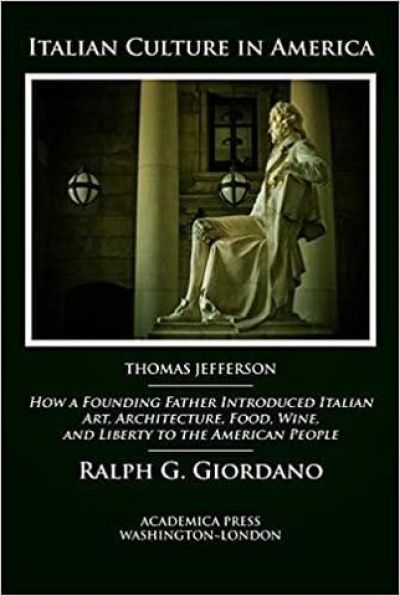In 1787, Thomas Jefferson, then Minister to France, visited several regions in northern Italy. He studied the agriculture and language, admired the architecture and art, and enjoyed the music, food, and wine. When he returned to America, he brought Italian culture with him, infusing it into everyday American life.
“Italian Culture in America: How a Founding Father introduced Italian Art, Architecture, Food, Wine, and Liberty to the American People” by architect, lecturer, educator, and author Ralph G. Giordano documents Thomas Jefferson’s accomplishments in bringing Italian culture to America. This year, April 13 is the 280th birthday of Thomas Jefferson (1743-1826) and “Italian Culture in America” is a birthday tribute.
Ralph writes, “Exploring Italian culture introduced to America by Thomas Jefferson reveals a significant influence from Ancient Rome, specifically the Pax Romana…a Latin term meaning ‘Roman Peace,’ refers to a period in Roman history from 27 BCE to 180 CE; considered a time of ‘peace and economic prosperity throughout the Empire.’…It was during the 200 plus year period of the Pax Romana that many of the Roman advancements in art, architecture, and engineering flourished.”
Chapter one provides a brief overview of this Roman prosperity; “the most famous explorers in history:” Columbus, Caboto, Vespucci and Verrazzano, Italian immigration during early colonization (before mid-1700), the culture of America during that time and how “life within the British colonies…eventually shaped Thomas Jefferson’s view of America.” Ralph notes, “Many colonists, such as Jefferson could be considered ‘first generation’ Americans as children of immigrant parents. It was also a generation, and those that followed, who only knew the land they were born onto and define themselves politically and culturally as ‘Americans.’”
The culture of America, though, was not defined. From the book: “The years 1740 to 1820, represented a revolutionary change in America. During that time, a growing desire for political independence by the American colonies from the British Empire fermented. In the ensuing years, an emergent revolutionary climate permeated through the colonies culminating in a rebellion and long drawn out war of separation from England. Prior to the American Revolution, the colonies were politically, economically, socially, and culturally dependent upon Great Britain.”
During this time, the early settlers from Italy arrived. Ralph quotes from the Library of Congress: “Throughout the colonial and early national periods, immigrants from the Italian peninsula maintained a small but well-established presence in the North American population. Italian craftsmen were renowned the world over, and many traveled to the New World to help build its new institutions, working as sculptors, woodworkers, and glassblowers. Thomas Jefferson had a particular affinity for Italian culture; he recruited Italian stonemasons to work on his home at Monticello and brought musicians from Italy to form the core of the Marine Band. In addition, he invented his own hand-operated pasta machine, the designs for which are still in the Library's collections.”
“Italian Culture in America” describes how Italian culture blended into American history and explains Jefferson’s outlook: “His early ‘Italian’ was interwoven from various experimentation, interaction with Italian immigrants, reading ancient Roman classics, and Renaissance philosophers, artists, and architects.” Ralph writes, “Those Roman and Italian Renaissance monuments Jefferson did not personally see were studied through the great Renaissance architect Andrea Palladio…Within Palladio’s text Jefferson became familiar with the ancient Roman and Renaissance works he later applied to buildings in the new American republic such as Washington D.C. and Monticello.”
As for America, itself: “It was not coincidence that the term ‘Republic’ was often used by Thomas Jefferson and by the Founders of America. (The word is derived from the Latin Res publica which translates loosely as ‘public affair’ or ‘for the people’). Therefore, the new nation was based mainly on Ancient Rome with a slight nod to the Ancient Greek idea of ‘democracy.’” Jefferson’s friend, Filippo Mazzei, also had an influence.
This well-documented volume presents a detailed look into how Italian culture was merged into the growth of a new nation, along with a detailed look into the life of Thomas Jefferson. Chapters cover every aspect noted in the subtitle, as well as Jefferson’s relationship with Maria Cosway and his tour of northern Italy. A bibliography provides the sources, and the extensive index is an added feature, generating a book about Italian American history that can be used in the classroom. Its historic value to the Italian American community also makes it a noteworthy resource in a personal library.



